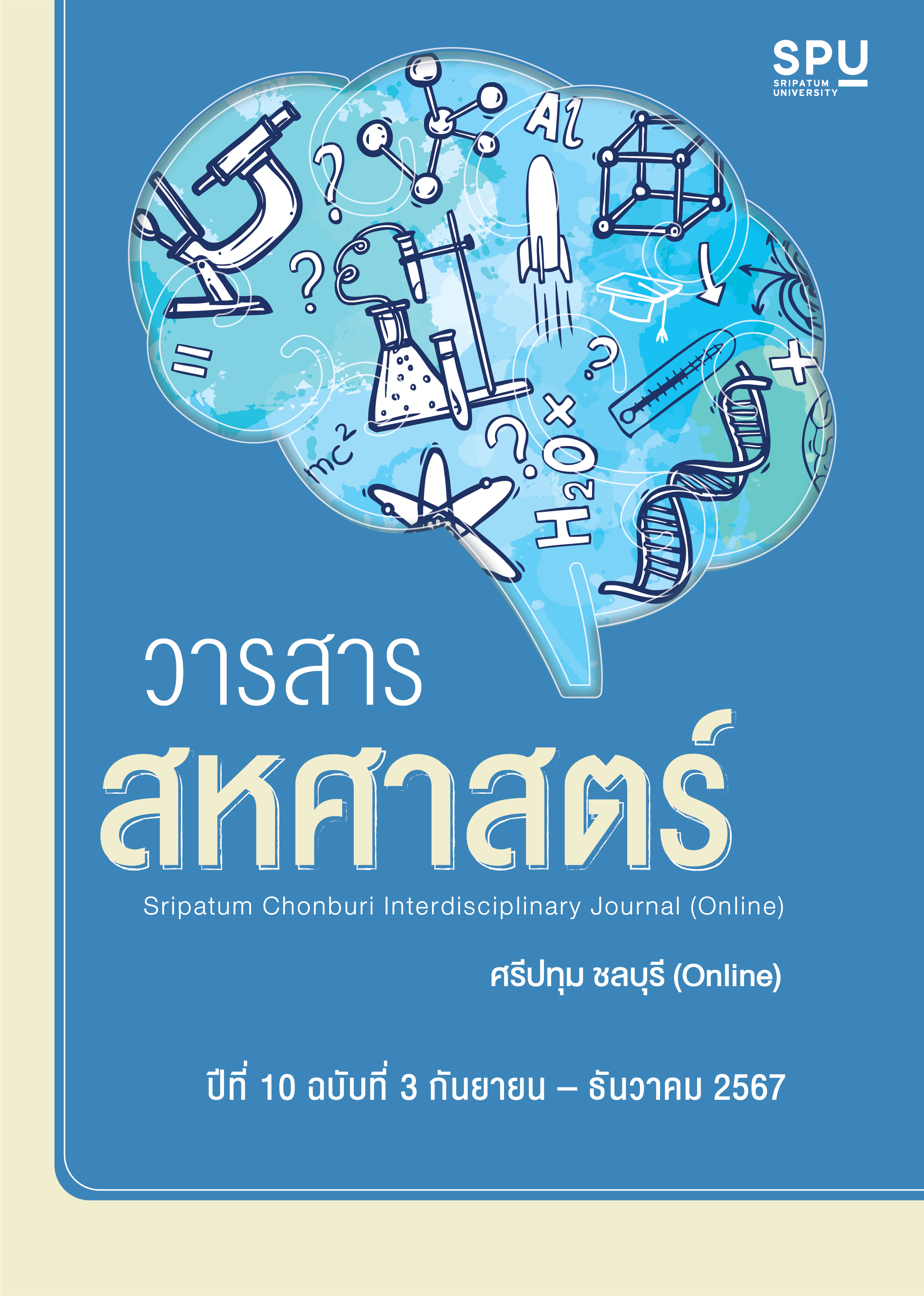GUIDELINES FOR CREATIVE TOURISM MANAGEMENT BASED ON THE CULTURAL CAPITAL OF BAN PUEK SUBDISTRICT, MUEANG DISTRICT, CHONBURI PROVINCE
Keywords:
Creative Tourism, Cultural Capital, Ban Puek SubdistrictAbstract
This research aims to 1) study the cultural capital of the Ban Puek Subdistrict community, Mueang District, Chonburi Province; 2) evaluate the potential for managing creative community tourism in Ban Puek Subdistrict, Mueang District, Chonburi Province; and 3) propose a management approach for creative tourism under the cultural capital of Ban Puek Subdistrict, Mueang District, Chonburi Province. This qualitative research study of Ban Puek Subdistrict, Mueang District, Chonburi Province consisted of: 1) in-depth interviews that were conducted with community leaders from the community tourism enterprise committee of Ban Puek Subdistrict. The study included a total of 15 local people involved in tourism, as well as 25 tourists; 2) A focus group meeting of 10 academics and tourism developers was involved in the research; and 3) the research also employed participatory observation through a purposive sampling method, and substantive analysis was used to analyze the data. The results were as follows: 1) The cultural capital of Ban Puek Subdistrict revealed that there are both important historical sites and artifacts within Wat Mai Ketu Ngam. The house features a weaving shed, provides food and snacks, and supports various occupations, such as weaving, rice farming, palm sugar production, gardening, and planting the "Ta Ya Mom" plant. 2) Ban Puk Subdistrict has the potential to manage creative community tourism by leveraging its cultural capital to foster tourism activities. It will also be developed into products for tourists to sell, helping tourists to travel to the community in a convenient way with various paths to choose from. The community provides facilities to accommodate the tourists, such as restrooms, a resting area, a tourist information center, and food and beverage outlets. The community also has homestays managed by the community tourism enterprise group of Ban Puek Subdistrict. Community tourism activities are diverse, such as visiting ancient temples over 200 years old, listening to history, watching a weaving demonstration, observing the profession of fresh oyster shucking, making tapioca starch, crafting it with woven fabrics, making desserts using local ingredients, and folding a lotus flower. The strategy for managing creative tourism within the Ban Puek community's cultural capital involves enhancing the community's tourism potential, fostering community engagement in creative tourism management, and promoting community tourism marketing.
References
กระทรวงการท่องเที่ยวและกีฬา. (ม.ป.ป.). แผนพัฒนาการท่องเที่ยวแห่งชาติ ฉบับที่ 3 (พ.ศ. 2566-2570) (ออนไลน์). เข้าถึงได้จาก: https://province.mots.go.th/ewtadmin/ewt/ranong/download/article/article_20230418122435.pdf [2566, 20 ธันวาคม].
กระทรวงการท่องเที่ยวและกีฬา. (2560). คู่มือการบริหารจัดการแหล่งท่องเที่ยวเชิงสร้างสรรค์ (ออนไลน์). เข้าถึงได้จาก: https://www.trdnrru.net/img/poster1/project01.pdf [2567, 15 มิถุนายน].
กฤชณัท แสนทวี, ภัทธิรา ธีรสวัสดิ์ และชัชฎา อัครศรีวร นากาโอคะ. (2562). แนวทางการจัดการนวัตกรรมการสื่อสารการตลาดการท่องเที่ยวเชิงสร้างสรรค์ โดยใช้ชุมชนเป็นฐาน. วารสารวิจัยเพื่อการปฏิรูปการเรียนรู้, 2(1), หน้า 1-11.
กฤธยากาญจน์ โตพิทักษ์ และอานันท์ นิรมล. (2561). รายงานวิจัยฉบับสมบูรณ์ การพัฒนาสื่อส่งเสริมกิจกรรมการท่องเที่ยวเชิงสร้างสรรค์ที่สะท้อนอัตลักษณ์และคุณค่าทางวัฒนธรรมชุมชนคนต้นน้ำคลองท่าแนะ จังหวัดพัทลุง (ออนไลน์). เข้าถึงได้จาก: http://rms.rdi.tsu.ac.th:82/abc/files/report020191203131349.pdf [2566, 20 ธันวาคม].
การท่องเที่ยวแห่งประเทศไทย. (2544). แผนปฏิบัติการ “การท่องเที่ยวเชิงนิเวศแห่งชาติ”. กรุงเทพฯ: การท่องเที่ยวแห่งประเทศไทย.
เกรียงศักดิ์ พราหมณพันธุ์, ชูศักดิ์ สุวิมลเสถียร, ธรรมศักดิ์ สงกา, มนัส แก้วบูชา, ศรัญญา ประสพชิงชนะ,ปาจรีย์ สุขาภิรมย์, พรทิพย์ พันธุ์ยุรา, สุภาภรณ์ เอี่ยมเข่ง, รุ่งอรุณ ดอนจันทร์ทอง, ศิริอร ศักดิ์วิไล, สกุลพีรพัฒน์ มั่งคั่ง, วัชรพงษ์ สุขีวงศ์ และรินจง เสริมศรี. (2562). โครงการแนวทางพัฒนาการท่องเที่ยวเชิงอนุรักษ์ : บ้านมาบหม้อ ตำบลบ้านปึก อำเภอเมือง จังหวัดชลบุรี. ชลบุรี: สำนักบริการวิชาการ มหาวิทยาลัยบูรพา.
ขวัญฤทัย เดชทองคำ. (2566). การพัฒนาศักยภาพแหล่งท่องเที่ยววิถีชุมชนเชิงสร้างสรรค์สู่ความยั่งยืน กรณีศึกษา: ชุมชนริมน้ำเจ้าพระยา บ้านเกาะเกิด จังหวัดพระนครศรีอยุธยา. วารสารวิชาการอยุธยาศึกษา, 15(2), หน้า 65-79.
ดรรชนี เอมพันธุ์. (2549). หลักนันทนาการและการท่องเที่ยว. กรุงเทพฯ: คณะวนศาสตร์ มหาวิทยาลัยเกษตรศาสตร์.
ดารณี พลอยจั่น. (2559). ทุนทางวัฒนธรรมของชาวเขาเผ่าม้งกับกลยุทธ์ส่งเสริมการท่องเที่ยวเชิงสร้างสรรค์. วารสารวิชาการนวัตกรรมสื่อสารสังคม, 4(1), หน้า 6-17.
ดาริน วรุณทรัพย์. (2561). รูปแบบการจัดการทุนทางวัฒนธรรมเพื่อการท่องเที่ยวเชิงสร้างสรรค์ในประเทศไทย. วิทยานิพนธ์ดุษฎีบัณฑิต สาขาวิชาการจัดการเพื่อการพัฒนา, บัณฑิตวิทยาลัย มหาวิทยาลัยราชภัฏราชนครินทร์.
ทิพย์สุวรรณ แซ่ลี้. (2561). รูปแบบเครือข่ายการจัดการท่องเที่ยวโดยชุมชนที่เหมาะสมของชุมชนบ้านอาลึ และชุมชนบ้านอ้อมแก้ว จังหวัดสุรินทร์ (อออไลน์). เข้าถึงได้จาก: https://www.esanpedia.oar.ubu.ac.th/e-research/sites/default/files/Thipsuwan_Saelee.pdf[2567, 15 มิถุนายน].
ธนกฤต ภัทร์ธราธร และเกรียงศักดิ์ สร้อยสุวรรณ. (2565). รูปแบบการท่องเที่ยวเชิงสร้างสรรค์บนฐานทุนทางวัฒนธรรม กรณีศึกษาไทดำ บ้านป่าหนาด จังหวัดเลย. วารสารวิชาการธรรมทรรศน์, 22(3), หน้า 141-157.
บุญเลิศ จิตตั้งวัฒนา. (2548). การพัฒนาการท่องเที่ยวแบบยั่งยืน. กรุงเทพฯ: ศูนย์วิชาการท่องเที่ยวแห่งประเทศไทย.
ประไพพิมพ์ สุธีวสินนนท์ และประสพชัย พสุนนท์. (2559). กลยุทธ์การเลือกตัวอย่างสำหรับการวิจัยเชิง คุณภาพ. วารสารปาริชาต มหาวิทยาลัยทักษิณ, 29(2), หน้า 31-48.
เปรมปรีดา ทองลา, เพ็ญศิริ สมารักษ์ และบุษรา บรรจงการ. (2566). รายงานฉบับสมบูรณ์ เรื่อง การพัฒนาศักยภาพการท่องเที่ยวเชิงสร้างสรรค์ ตำบลบางสระเก้า จังหวัดจันทบุรี (ออนไลน์). เข้าถึงได้จาก: https://eresearch.rbru.ac.th/pdf-uploads/thesis-2111-file01-2024-04-25-14-37-13.pdf
, 15 มิถุนายน].
วาสนา อาจสาลิกรณ์, รัษฎากร วินิจกุล และพิษณุ บุญนิยม. (2563). ทุนทางวัฒนธรรมกับการส่งเสริมศักยภาพ
ชุมชนท่องเที่ยว OTOP นวัตวิถีไทดำ บ้านวังน้ำ ตำบลวังยาง อำเภอคลองขลุง จังหวัดกำแพงเพชร. วารสารพิกุล, 18(2), หน้า 269-287.
วิวัฒน์ชัย บุญยภักดิ์. (2550). การประเมินศักยภาพแหล่งท่องเที่ยว. กรุงเทพฯ: การท่องเที่ยวแห่งประเทศไทย.
ศรัญญา ประสพชิงชนะ, ปาจรีย์ สุขาภิรมย์ และอมรฉัฐ เสริมชีพ. (2565). การสำรวจองค์ความรู้ทรัพยากรวัฒนธรรม ชุมชนบ้านมาบหม้อ ตำบลบ้านปึก อำเภอเมือง จังหวัดชลบุรี. วารสารวิชาการมนุษยศาสตร์และสังคมศาสตร์ มหาวิทยาลัยบูรพา, 30(2), หน้า 155-178.
สัณห์ไชญ์ เอื้อศิลป์ และธีร์ โคตรถา. (2562). การสร้างสรรค์อัตลักษณ์ตราสินค้าแฟชั่นจากหัตถกรรมสิ่งทอ ชุมชนบ้านปึก-อ่างศิลา จังหวัดชลบุรีด้วยเทคนิคการตัดเย็บขั้นสูงเพื่อจัดจำหน่ายในตลาดสินค้าแฟชั่นสำเร็จรูป. Veridian E-Journal, Silpakorn University (Humanities, Social Sciences
and arts), 12(5), หน้า 1108-1123.
สำนักนายกรัฐมนตรี. (2566). แผนแม่บทภายใต้ยุทธศาสตร์ชาติ (พ.ศ. 2566-2580) (ฉบับแก้ไขเพิ่มเติม) (ออนไลน์). เข้าถึงได้จาก: http://nscr.nesdc.go.th/wp- content/uploads/2023/03/masterplan_updated2023_080363.pdf [2566, 20 ธันวาคม].
อินฟอร์เมชั่น โพรวายเดอร์ แอนด์ คอนซัลแตนท์. (2556). บทสรุปผูบริหาร (Executive Summary)โครงการสงเสริมการลงทุนธุรกิจทองเที่ยวเชิงสรางสรรค (Creative Tourism) (ออนไลน์). เข้าถึงได้จาก: http://tourismlibrary.tat.or.th/medias/T24129.pdf [2566, 20 ธันวาคม].
Dickman, S. (1996). Tourism: An introductory text (2nd ed.). Sydney, Australia: Hodder Education.
Flick, U. (1998). An introduction to qualitative research : Theory, method and applications. London, England: Sage.
Lofland, J. & Lofland, L. H. (1984). Analyzing Social Settings (2nd ed.). Belmont, CA: Wadsworth.
Nastasi, B. K. & Schensul, S. L. (2005). Contributions of qualitative research to the validity of intervention research. Journal of School Psychology, 43(3), pp. 177-195.
Onwuegbuzie, A. J. & Leech, N. L. (2007). Sampling designs in qualitative research: making the sampling process more public. Qualitative Report, 12(2), pp. 238-254.
Richards, G. & Raymond, C. (2000). Creative Tourism. ATLAS news, 23(8), pp. 16-20.
Richards, G. (2009). Creative Tourism and Local Development. In Creative Tourism: A Global Conversation: How to Provide Unique Creative Experiences for Travelers Worldwide, Santa Fe: Sustone Press.
Ritchie, J. & Spencer, L. (2002). Qualitative data analysis for applied policy research. In Analyzing qualitative data (pp. 173-194). Routledge.
Throsby, D. (2001). Economy and Culture. Cambridge, Anglia: The Press Syndicate of the University of Cambridge.
UNESCO. (2006). Towards sustainable strategies for creative tourism. In Discussion Report of the Planning Meeting for the 2008 International Conference on Creative Tourism. Santa Fe, New Mexico, pp. 25-27.
UNESCO Digital Library. (2020). UNESCO Creative Cities Network for sustainable development (Online). Available: https://unesdoc.unesco.org/ark:/48223/pf0000375210 [2024, June 15].



